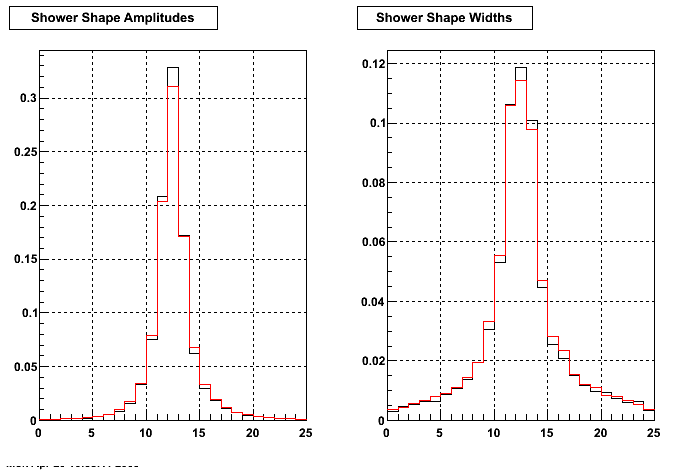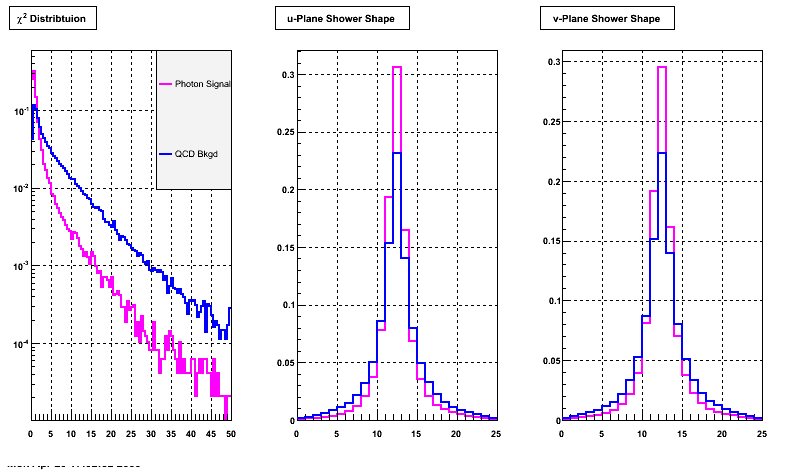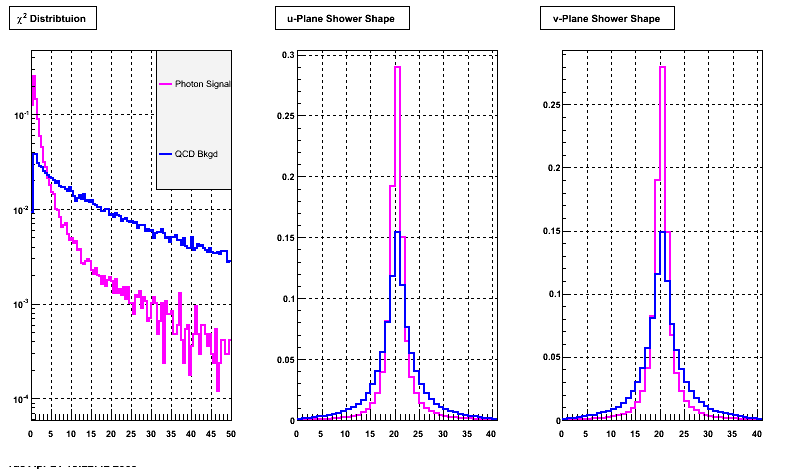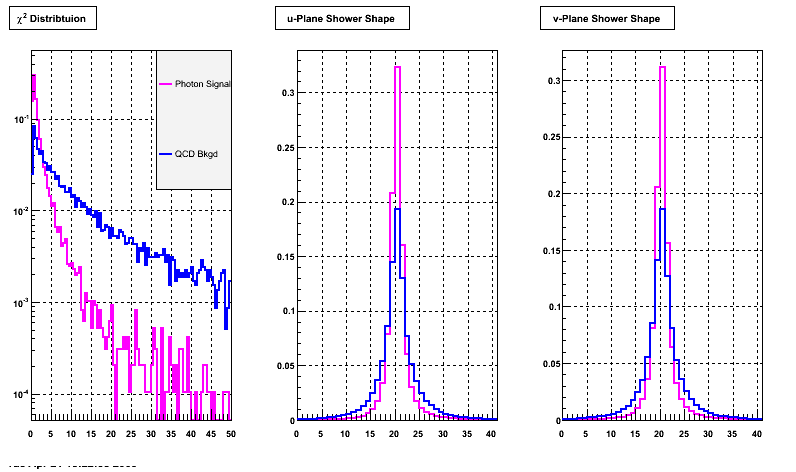Investigating Shower Shapes & Chi2
Introduction
Idea here is to try to revive the chi2 method and to see if adding a chi2 cut to the conversion method selection - CDF did this - makes sense.
Creating the Photon Shapes
I use the MIT-filtered MC. I select events that pass all requirements of the conversion method - isolation, hadronic veto, charged particle veto and analysis cut. I don't require a trigger. I do require that the photon candidate be matched to a prompt photon within a cone of R=0.3 The shape amplitude and widths I get are shown in the figure below. Two colors are u & v planes: black = u and red = v.

Calculating Chi2
Now I run over the signal & bkg MC and calculate the reduced chi2 for each event. I only require photon candidates with pt>5 GeV. The result is in the figure below - I also show the u & v shower shapes for comparison.

Comments
While my shower shape amplitudes and widths are consistent with Hal's star note, Figure 24, I'm not seeing the awesome separation seen by Pibero.
At this point I'm at a loss. I'm confident in my shower shapes. Is it that I'm not running the same MC as Pibero? What is in the MIT QCD sample? Is it because the width of the chi2 is still too large? I do notice that the widths are comparable to the differences between the signal & bkg shower shapes, which would explain the crummy separation.
I would like to get a sample of pions from the data and run this and compare the photons to the pions.
Update April 21
Based on discussion with Hal & Jason I decided to raise the pt threshold to 8 GeV and expand the shower shape to +/-20 strips of the maximum to try to pick out more photons. I looked at the signal & background cut efficiencies for various chi2 at various event selection stages.
The figure below shows the chi2 distribution and u &v shower shapes for events passing the pt > 8 GeV cut.

I have much better separation than before. Even though the chi2 distributions are stil peaking in about the same place the tails are falling off a noticably different rates. This is because the shower shapes are now more different. If I do a quick Sig Eff/Bkg Rej at various chi2 cuts I get the following:
Chi2<=1: Sig Eff=0.46, Bkg Rej=0.89
Chi2<=2: Sig Eff=0.72, Bkg Rej=0.78
Chi2<=3: Sig Eff=0.82, Bkg Rej=0.70
Chi2<=4: Sig Eff=0.87, Bkg Rej=0.63
Chi2<=5: Sig Eff=0.91, Bkg Rej=0.57
Chi2<=6: Sig Eff=0.93, Bkg Rej=0.52
Chi2<=7: Sig Eff=0.94, Bkg Rej=0.48
Chi2<=8: Sig Eff=0.95, Bkg Rej=0.44
Chi2<=9: Sig Eff=0.96, Bkg Rej=0.41
Chi2<=10: Sig Eff=0.97, Bkg Rej=0.37
Now I check what happens if I require an isolation cut. The cut is E_T(1X1c)/E_T(R=0.3)>0.85. I get the distributions in the figure below.

Now my Sig Eff/Bkg Rej values are:
Chi2<=1: Sig Eff=0.55, Bkg Rej=0.81
Chi2<=2: Sig Eff=0.81, Bkg Rej=0.67
Chi2<=3: Sig Eff=0.89, Bkg Rej=0.58
Chi2<=4: Sig Eff=0.92, Bkg Rej=0.53
Chi2<=5: Sig Eff=0.94, Bkg Rej=0.46
Chi2<=6: Sig Eff=0.96, Bkg Rej=0.41
Chi2<=7: Sig Eff=0.96, Bkg Rej=0.39
Chi2<=8: Sig Eff=0.97, Bkg Rej=0.36
Chi2<=9: Sig Eff=0.98, Bkg Rej=0.33
Chi2<=10: Sig Eff=0.98, Bkg Rej=0.30
New comments: This is looking much better even though I still don't have the same shape as Pibero. Maybe one more round of PT and shower shape changes can be attempted. Otherwise I think investigating a chi2<=5 after the isolation cut - which keeps ~95% of signal and rejects ~50% of background is reasonable.
- aliceb's blog
- Login or register to post comments
